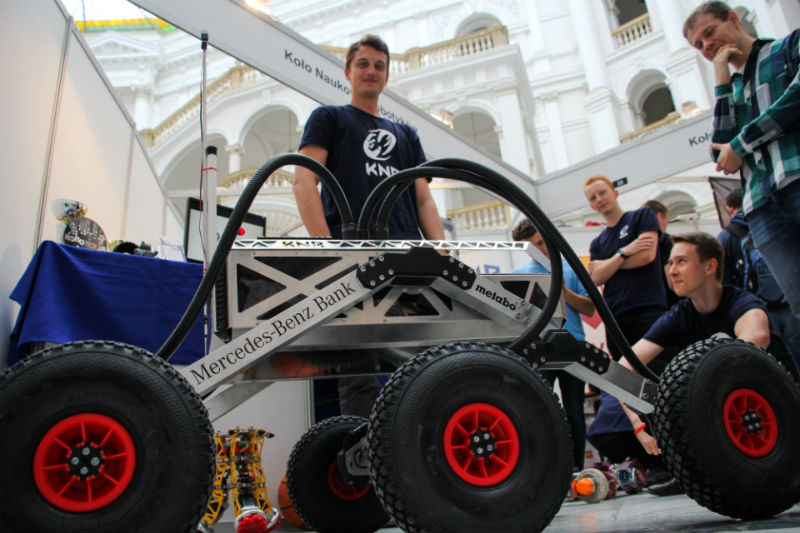Meet HAL-062, a Mars rover built by WUT students

Students have been working on HAL-062 since November 2016, source: the Robotics Student Research Group
A team of the Robotics Student Research Group has created a robot to enter the Mars rover competition University Rover Challenge. The best student-built structures from all over the world will compete on a desert in Utah, USA, in an environment that closely resembles what it is like on Mars.
“The whole experiment is about simulating the life of astronauts on Mars and their work alongside robots,” says Adam Sikorski, who is heading the project. “Daily situations that could happen during a mission like that are recreated.”
A robot, such as this one, is expected to be able to handle a number of functional tasks, e.g. operate a control panel, fetch and deliver equipment/tools to an astronaut or drill soil samples for analysis. “From an engineering perspective, autonomy is the most exciting part,” stresses Adam Sikorski, “If communication with the base station is lost, a robot will be able to carry on with its task on its own or return to the base station safe and sound.”
Going the extra mile
Students in the Robotics Student Research Group that operates at the Faculty of Power and Aeronautical Engineering take part in many robotics competitions. “We take 20 to 30 prizes home a year,” says Adam Sikorski, “Our aim is continuous growth, hence our decision to raise the bar and take our chances with a more of an advanced project. We resolved to create a Mars rover designed for University Rover Challenge, the most prestigious and demanding student competition in robotics.”
Our students have been working on HAL-062 since November 2016. However, first concepts emerged about half a year before. At the time, they built a 1:2 scale version of the rover as a team of three. This was a testbed for numerous solutions which were later deployed in HAL-062. “The essential systems such as communication, actuator controllers or suspension found their way into our proper design,” says Adam Sikorski.
Complex system and cosmic requirements
How did our students know what to do if none of them had ever built a rover before? “As I said before, we have a vast experience in mobile robot construction,” Adam Sikorski smiles. “On top of that, we had to review the information available, including about NASA or the European Space Agency solutions. We built on that in creating our design.
And this means hours on end of designing, assembling, testing and improving the structure. The rover mechanics alone comprises approximately one thousand elements. And then there is electronics, wiring and all the connectors.”
Making a dream come true and building a Mars rover would be impossible without financial support. It was largely provided by the University but aid came from elsewhere too. Mercedes-Benz Bank Poland also offered support to our students. Certainly, the costs of HAL-062 design are only a fraction of what a large space-related project would cost. Hundreds of millions zlotys are needed to cover such a venture. The main reason is the rigorous requirements for certification of each and every component.
The University Rover Challenge will be running from May 31 through June 2, 2018. More than 90 teams from across the globe competed in the first preliminaries, with as many as 6 teams from Poland qualifying for the finals. Our students will set off for the USA already a few days in advance to allow the time for tests and final touch-ups. “We are realists but we will only be fully satisfied if we manage to hit the top three,” says Adam Sikorski.
The Robotics Student Research Group (KNR) Team members are: Adam Sikorski, Konrad Aleksiejuk, Filip Niemczyk, Marcin Baran, Klaudia Palak, Adam Swiderski, Mikołaj Jaworski, Zofia Tyczyńska, Piotr Pietrzak, Andrzej Sochaczewski and Konrad Husiatyński.
The travel to the competition is arranged under the project entitled “Activities of the Astronautic Student Research Group. A mobile robot design for the international competition 2018 University Rover Challenge” – “The Best of the Best 2.0” funded by the European Union under the Operational Program Knowledge Education Development (POWER) of the Ministry of Science and Higher Education.
Agnieszka Kapela
Promotion and Information Office







